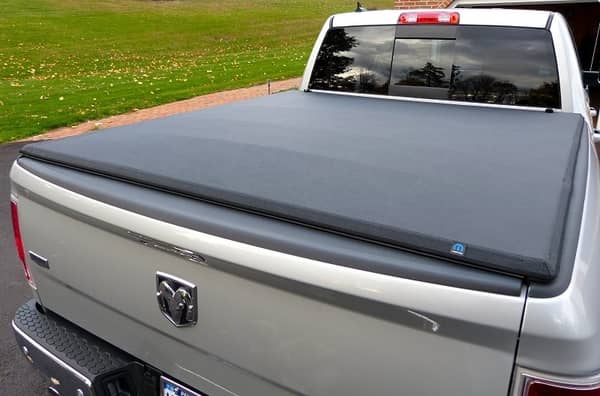One of the easiest and cheapest ways to improve the looks of your truck is a tonneau cover. A big problem with the cloth version of the cover is if it isn’t installed correctly, it can become loose and flap in the wind.
How do you stop a tonneau cover from flapping? During installation, the cover needs to be tightened evenly at all screws. If the cap is not tightened correctly, it can become stretched by the temperature change. This stretch is what leads to the flapping and degeneration of the tonneau cover.
The biggest problems with your tonneau cover can be prevented by following a few simple rules. Read on to learn about maintaining the integrity of your cover.
How To Stop A Flapping Tonneau Cover
The trick with a sagging cover is going to be tension. On some models of the cover, there could be an extra set of tensioner knobs. These knobs can be situated at spaced intervals, around the bed rail covers, and will work at cinching down their area.
If a cover has been on your truck for more than five or six years, you might need a new one. If your vehicle is mainly used on the highway, a good idea might be to invest in a solid cover. These are a bit more expensive but could come with a lifetime warranty, depending on the model.
In the end, a flapping cover can only be tightened so much. If the flapping begins to erode the quality of the truck, then it must go. When the tonneau cover flaps, it could damage materials inside the payload. If you notice that luggage has become wet while inside, you could have a leak in your tracks. A significant upgrade would be a replacement model for your current or a new solid cover.
How To Install A Tonneau Cover
Most tonneau covers come with a set of rails that must be attached to the bed’s sides. These rails are the basis for several different versions of the tonneau. Even the more massive clamshell-style tonneau covers will have a rail system to support the extra weight. The types of different rails based covers are:
- Tri-Fold
- Roll N Lock
- Roll Up

With a Tri-Fold, the sections will be held closer to the rails, meaning that a flapping couldn’t occur unless there was a problem securing the cover to the tracks. For the Roll N Lock, you have solid pieces on the top that move around like a puzzle. Neither of those has issues with flapping.
If you’re in the market for a reliable soft tri-fold tonneau cover, I highly recommend that Extang Trifecta 2.0 which I happened to write a short review for.
The Roll-Up is the most prone to have problems keeping tautness. If the cover isn’t situated in the frame at the right length, it will cause the sagging and moving that we are trying to avoid. Prolonged bouts with the weather will degrade the Roll-Up tonneau cover, and a subpar installation will reveal this.
To install your tonneau cover for a long a durable term of service follow these steps:
- Clean it up
- Weather seal
- Seat the rails
- Clamp the clamps
- Clamps go home
- Align the cover
- Clamp it down
- Rails at center
- Tailgate clamps
- Weather seals
- Test it out
Clean it up
Depending on the age of your truck, there could be some cleaning to do atop the bed rails. Some covers will come with a cleaning solution and wipes to cleanse the area. If there are bed rails, they will need to be removed and holes filled to prevent damage to the tonneau cover.
Weather seal
A significant failing in some covers is that they have no way to siphon off water and snow that falls onto it. The rails will need to be armored against the elements, and your cover should come with a sealant. This isn’t a cure-all for the weather beating on your cover but will definitely extend life.
Seat the rails
Once you have a thoroughly clean surface, you can begin to seat the rails at the bedside. They should be close to the edges, but should not be screwed down just yet. Leaving them loose is necessary for the following steps.
Clamp the clamps
Inside the packing material for the tonneau cover should be a tiny bin filled with metal pieces. These pieces will need to be assembled to form the clamps. Take each end and connect it to the long back piece that corresponds to the brace you are constructing.
Clamps go home
Now that you are working with some newly assembled clamps, it is time to clamp down the rails for the tonneau cover. Keep in mind that these clamps are only a place holder until the fabric is placed. They should be holding the tracks loosely in place as you maneuver around.
At the end of this step, you should take extra time to make sure that the rails are level and even. Do not cinch them all the way down until every step has been covered. Having to loosen half the bolts to make any progress with the installation is a waste of your time.
Align the cover
This step is one of the most important when it comes to protecting against flapping and wind damage. What makes it so important is that if the cover is uneven, then you will spend the life of the cover fighting to make it right again. A good rule of thumb is to start with the corners and work your way down. If the cover is even at the top and the center, everything should be correct.
When you have an even surface, you should begin to look for places that shims can be added. This is an optional step, but making the cover tight is the purpose of the install. If you need to add multiple clamps of shims, now is the time to make it happen.
Clamp it down
Now that everything is right and tight, you should make it permanent. Use whatever kind of tool is needed, usually an alan wrench or socket, and tighten the clamps down. It should be noted that over tightening may cause the braces to strip and lose effectiveness.
For the clamps at the top of the bed, it is time to clamp down. Be absolutely positive before you move on that everything is positioned correctly.
Rails at center
An unnecessary step, absolutely. But critical none the less. The improper placement of the rail system could mean a shorter life for the cover and possible damage to your truck. If this step isn’t done correctly, you can count on several hours trying to make it right.
Tailgate clamps
The clamps that reside just inside the closed tailgate should be tightened next. These clamps will secure the cover and rails to the truck. To say that these must be as tight as possible is an understatement. The cover’s life depends on the tailgate and other clamps being capable of holding down the lid.
Weather seals
This could be an optional step for some models. Inside the packaging could be a series of tubes or gutters that will allow water flow to exit the tracks. Clearing water from them is essential in keeping them functional and working correctly.
Test it out
Now all the hard work has been done; it is time to take it for a test. A simple rolling and unrolling of the canopy will be enough to see if you have done your job correctly. If the tarp doesn’t run successfully or becomes uneven, you should loosen some of the clamps and make it work.
Conclusion
As you can see, several steps must be implemented properly in order to prevent any flapping from your tonneau cover in the future. A non-flapping tonneau cover will eliminate noise while driving, make your truck more presentable, and over course better protect your cargo. Tighten those clamps properly and drive safely out there!
If you’re thinking of different ways to accessorize your truck or make it more functional, consider checking out my recommended accessories page. I spent a good amount of time picking out mods that can be useful for most pickup trucks.

